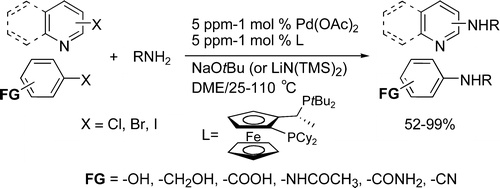Highly Reactive, General and Long-Lived Catalysts for Palladium-Catalyzed Amination of Heteroaryl and Aryl Chlorides, Bromides and Iodides: Scope and Structure-Activity Relationships.
J. Am. Chem. Soc., 2008, 130 (6586-6596)
View on publisher site
Abstract
We describe a systematic study of the scope and relationship between ligand structure and activity for a highly efficient and selective class of catalysts containing sterically hindered chelating alkylphosphines for the amination of heteroaryl and aryl chlorides, bromides, and iodides. In the presence of this catalyst, aryl and heteroaryl chlorides, bromides, and iodides react with many primary amines in high yields with part-per-million quantities of palladium precursor and ligand. Many reactions of primary amines with both heteroaryl and aryl chlorides, bromides, and iodides occur to completion with 0.0005–0.05 mol % catalyst. A comparison of the reactivity of this catalyst for the coupling of primary amines at these loadings is made with catalysts generated from hindered monophosphines and carbenes, and these data illustrate the benefits of chelation. Studies on structural variants of the most active catalyst indicate that a rigid backbone in the bidentate structure, strong electron donation, and severe hindrance all contribute to its high reactivity. Thus, these complexes constitute a fourth-generation catalyst for the amination of aryl halides, whose activity complements catalysts based on monophosphines and carbenes.
Read on publisher's site